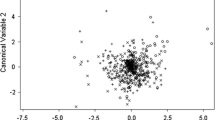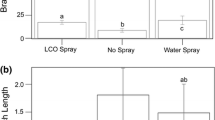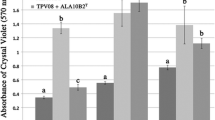Abstract
Axenic seedling bioassays were performed on white clover, vetch, and alfalfa to assess the variety and dose responses of biological activities exhibited by membrane chitolipooligosaccharides (CLOSs) from wild type Rhizobium leguminosarum bv. trifolii ANU843. Subnanomolar concentrations of CLOSs induced deformation of root hairs (Had) and increased the number of foci of cortical cell divisions (Ccd) in white clover, some of which developed into nodule meristems. In contrast, ANU843 CLOSs were unable to induce Had in alfalfa and required a 104-fold higher threshold concentration to induce this response in vetch. Also, ANU843 CLOSs were not mitogenic on either of these non-host legumes. In addition, CLOS action also increased chitinase activity in white clover root exudate. Thus, the membrane CLOSs from wild type R. leguminosarum bv. trifolii are fully capable of eliciting various symbiosis-related responses in white clover in the same concentration range as extracellular CLOSs of other rhizobia on their respective legume hosts. These results and our earlier studies indicate that membrane CLOSs represent one of many different classes of bioactive metabolites made by R. leguminosarum bv. trifolii which elicit more intense symbiosis-related responses in white clover than in other legumes. Therefore, CLOSs evidently play an important role in symbiotic development, but they may not be the sole determinant of host-range in the Rhizobium-clover symbiosis.
Similar content being viewed by others
Abbreviations
- Ccd:
-
cortical cell division
- CLOS:
-
chitolipooligosaccharide
- Had:
-
root hair deformation
References
Bhuvaneswari T V and Solheim B 1985 Root hair deformation in the white clover/Rhizobium trifolii symbiosis. Physiol. Plant. 63, 25–34.
Bjourson A J, Cooper J E, Orgambide G and Dazzo F B 1995 Isolation of symbiosis-specific plant mRNA from Trifolium repens roots by DDRT-PCR and subtraction hybridization-PCR. In Nitrogen Fixation: Fundamentals and Applications. Eds. I Tikhonovich, N Provorov, V Romanov and W Newton. p 493. Kluwer Academic Publishers, Dordrecht, the Netherlands.
Carlson R W, Price N P and Stacey G 1994 The biosynthesis of rhizobial lipo-oligosaccharide nodulation signal molecules. Mol. Plant-Microbe Interact. 7, 684–695.
Cedergren R, Lee J, Ross K and Hollingsworth R I 1995 Common links in the structure and cellular localization of Rhizobium chitolipooligosaccharides and general Rhizobium membrane phospholipid and glycolipid components. Biochemistry 34, 4467–4477.
Dazzo F B 1982 Leguminous root nodules. In Experimental Microbial Ecology. Eds. R Burns and J H Slater. pp 431–446. Blackwell Scientific Publications, Oxford, UK.
Dazzo F B and Petersen M A 1989 Applications of computer-assisted image analysis for microscopic studies of the Rhizobium-legume symbiosis. Symbiosis 7, 193–210.
Dazzo F B, Truchet G L, Hollingsworth R I, Hrabak E M, Pankratz H S, Philip-Hollingsworth S, Salzwedel J L, Chapman K, Appenzeller L, Squartini A, Gerhold D and Orgambide G G 1991 Rhizobium-lipopolysaccharide modulates infection thread development in white clover root hairs. J. Bacteriol. 173, 5371–5384.
Hollingsworth R, Squartini A, Philip-Hollingsworth S and Dazzo F B 1989 Root hair deforming and nodule initiating factors from Rhizobium trifolii. In Signal Molecules in Plants and Plant-Microbe Interactions. Ed. B J J Lugtenberg. pp 387–393. Springer-Verlag, Berlin, Germany.
Kuranda M J and Robbins P W 1987 Cloning and heterologous expression of glycosidase genes from Saccharomyces cerevisiae. Proc. Natl. Acad. Sci. USA 84, 2585–2589.
Lerouge P, Roche P, Faucher C, Maillet F, Truchet G, Promé J-C and Dénarié J 1990 Symbiotic host-specificity of Rhizobium meliloti is determined by a sulphated and acylated glucosamine oligosaccharide signal. Nature 344, 781–784.
Li D and Hubbell D H 1969 Infection thread formation as a basis of nodulation specificity in Rhizobium-strawberry clover association. Can. J. Microbiol. 15, 1133–1136.
Orgambide G G, Lee J, Hollingsworth R I and Dazzo F B 1995 Structurally diverse chitolipooligosaccharide Nod factors accumulate primarily in membranes of wild type Rhizobium leguminosarum biovar. trifolii. Biochemistry 34, 3832–3840.
Orgambide G G, Philip-Hollingsworth S, Hollingsworth R I and Dazzo F B 1994 Flavone-enhanced accumulation and symbiosis-related biological activity of a diglycosyl diacylglycerol membrane glycolipid from Rhizobium leguminosarum biovar trifolii. J. Bacteriol. 176, 4338–4347.
Pan S Q, Ye X S, and Kuc J 1991 A technique for detection of chitinase, β-1,3-glucanase, and protein patterns after a single separation using polyacrylamide gel electrophoresis or isoelectrofocusing. Phytopathology 81, 970–974.
Philip-Hollingsworth S, Hollingsworth R I and Dazzo F B 1991 N-acetylglutamic acid: an extracellular nod signal of Rhizobium trifolii ANU843 that induces root hair branching and nodule-like primordia in white clover roots. J. Biol. Chem. 266, 16854–16858.
Philip-Hollingsworth S, Orgambide G G, Bradford J J, Smith D K, Hollingsworth R I and Dazzo F B 1995 Mutation or increased copy number of nodE has no effect on the spectrum of chitolipooligosaccharide Nod factors made by Rhizobium leguminosarum bv. trifolii. J. Biol. Chem. 270, 20968–20977.
Relić B, Talmont F, Kopcinska J, Golinowski W, Promé J C and Broughton W J 1994 Biological activity of Rhizobium sp. NGR234 Nod-factors on Macroptilium atropurpureum. Mol. Plant-Microbe Interact. 6, 764–774.
Spaink H P, Sheeley D M, van Brussel A A N, Glushka J, York W S, Tak T, Geiger O, Kennedy E P, Reinhold V N and Lugtenberg B J J 1991 A novel highly unsaturated fatty acid moiety of lipooligosaccharide signals determines host specificity of Rhizobium. Nature 354, 125–130.
Staehelin C, Schultze M, Kondorosi E and Kondorosi A 1995 Lipochitooligosaccharide nodulation signals from Rhizobium meliloti induce their rapid degradation by the host plant alfalfa. Plant Physiol. 108, 1607–1614.
Truchet G, Roche P, Lerouge P, Vasse J, Camut S, De Billy F, Promé J C and Dénarié J 1991 Sulphated lipooligosaccharide signals of Rhizobium meliloti elicit root nodule organogenesis in alfalfa. Nature 351, 670–673.
Yao P Y and Vincent J M 1976 Factors responsible for curling and branching of clover root hairs by Rhizobium. Plant and Soil 45, 1–16.
Author information
Authors and Affiliations
Rights and permissions
About this article
Cite this article
Orgambide, G.G., Philip-Hollingsworth, S., Mateos, P.F. et al. Subnanomolar concentrations of membrane chitolipooligosaccharides from Rhizobium leguminosarum biovar trifolii are fully capable of eliciting symbiosis-related responses on white clover. Plant Soil 186, 93–98 (1996). https://doi.org/10.1007/BF00035061
Issue Date:
DOI: https://doi.org/10.1007/BF00035061




